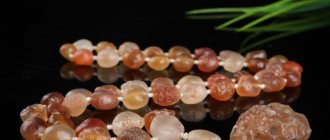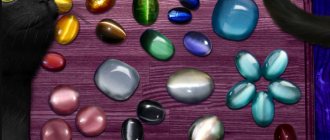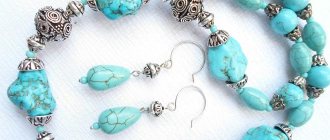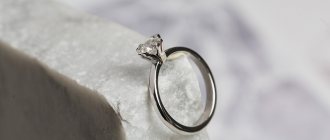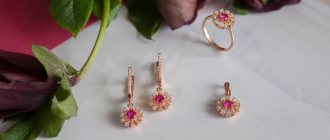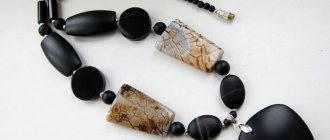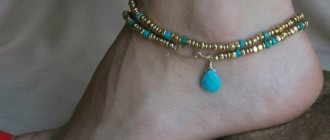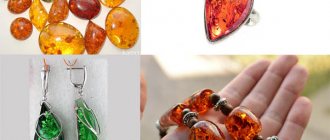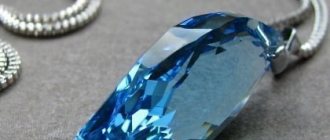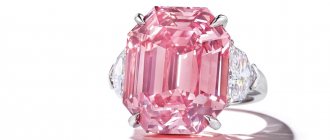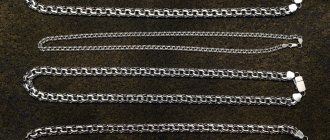Where does jewelry material come from?
Amber is the resin of a coniferous tree that hardened thousands of years ago. There is plenty of it on the planet, but jewelry-quality specimens are rare. Raw materials are processed, becoming ornamental or semi-precious. This is refined amber. Even ancient masters knew how to obtain it by boiling the starting material in honey until it turned red. Muddy stones were clarified by boiling in flax or colza oil.
Currently, jewelers have access to modern heat treatment methods. Although the old ones are not forgotten.
Fifth Throat Chakra Stone
Prolonged wearing of amber in the throat area helps to open the fifth chakra - Vishuddha. In addition to physical wellness, this also gives a lot of pleasant changes on the psychological, emotional and mental level. You will understand people better, and they, in turn, will listen and learn to hear you. The opened fifth chakra is the acquisition of self-confidence, the beginning of self-realization, the awakening of creative principles, the ability to form a personal opinion and correctly convey it to others. For business people, amber jewelry in the throat area are talismans that give independence and freedom.
It is believed that each amber stone has its own specificity. Some enthusiasts argue that the stone has its own character, which should be combined with the character of its owner. No one denies that the color, shape and texture of the objects around us influence us in one way or another.
Range
In jewelry, the mineral is used independently or as an insert into jewelry. Depending on this, there are two types of accessories:
- amber jewelry: the stone is inserted into necklaces, chokers, bracelets, pendants without frames;
- jewelry with amber: earrings, rings, pendants in braided frames.
The most popular are beads and bracelets made from lightly processed stones. Links of different sizes, regular shape or fancy. A necklace made of amber of any color looks impressive.
Application in medicine
Amber has healing properties. It has been established that the stone helps eliminate any pathologies and benefits the body as a whole. Useful features of the nugget:
- Optimizing brain function.
- Stabilization of metabolism.
- Prevention and treatment of colds.
- The necklace helps eliminate breathing problems.
- Green amber in the form of earrings improves hearing and vision.
- Small amber beads will help get rid of problems associated with the thyroid gland.
- Body jewelry protects against skin problems.
- Hepatitis, gastrointestinal tract, cardiovascular system and nerves will be strengthened by green amber.
Who is amber stone suitable for? – Absolutely everyone, since there are no contraindications. If dizziness and discomfort, as well as tingling, occur during treatment, the stone should be removed.
Setting, cutting of jewelry
Natural amber is soft, so the frame performs several functions: aesthetics, protection, design. Braid is used on vulnerable jewelry such as rings or rings.
Ring with amber
The frame is selected according to the size and quality of the stone: gold, silver or simpler metals.
When processing amber, be careful when creating cabochons or other forms of soft outlines. The cut is rare.
| Property | Description |
| Chemical formula | C40H64O4 |
| Color | From yellow to reddish-brown. |
| Transparency | Translucent |
| Shine | Smolyanoy |
| Kink | Conchoidal |
| Hardness | 2,5 |
| Specific gravity | 1,05-1,1 |
Who and how to wear amber
The gem is democratic, suitable for all ages, styles and occasions. There are women's and men's jewelry. But they are too noticeable, so when selecting and using them, compliance with the rules is required.
Color, shape
Light stones are suitable for teenagers or young people, while darker stones are suitable for older people or men.
The shape of the beads or inserts depends on the style and purpose of the jewelry. A classic sphere or other regular shapes are appropriate for business attire and serious people. Fancy, colorful ones will appeal to creative people, children or teenagers. Welcome as an addition to a costume for a friendly party, get-together, or walk.
Amber beads
Appearance type
The range of gems is varied, so amber jewelry can be selected to suit all types of appearance:
- for brunettes, brown-haired women, owners of red hair - yellow-brownish shades;
- platinum blondes - milky white, greenish shades;
- blond hair and skin – white, green pebble;
- tan or natural dark skin - shades of cognac.
Properly selected jewelry will harmoniously fit into the image and enhance the natural advantages of the hostess.
Compatibility, number of decorations
Amber in jewelry is combined with outfits of different shades:
- yellow-golden stones look good against a background of green, coffee, beige, brown, blue, or ocher suit or dress;
- for white, gray, black clothes, all colors and combinations of stones are suitable;
- expensive white amber will elevate a dark-colored wardrobe.
The inserts of rings, earrings, links of a necklace or bracelet are not miniature, so several jewelry pieces should not be worn at once: they will create a heaviness effect.
Bracelet with amber
Option for the office: earrings plus a ring or brooch in silver.
For men
For men, we offer gold and silver cufflinks, tie clips, rings, and key chains. Jewelry stones are rich, muted colors: cognac, ocher, cherry, intense green, black.
Types and color
The classic version of the sun stone is yellow with a brown tint. There are other types of mineral. Structural parameters and color are formed based on the characteristics of nature at the time of formation of the nugget. The mineral is formed from pine resin that gets into the soil. The stone gets its bright color and lightness from being in the fresh air and sun.
There are over 300 shades of sunstone, ranging in color from white to black. The most common mineral is yellow with a brown tint. Orange amber is often found. The red mineral is called dragon's blood, as it is similar to a ruby and is a rare and expensive stone.
White amber has a yellow color, but acquires its white color due to inclusions. The green color of the stone comes from pyrites and algae. Colorless stones are formed from wax. Blue amber is mined in the Dominican Republic. The black stone is completely opaque and is called jet. Some types of amber contain traces of flora or fauna, which gives the nuggets value.
The following types of stone exist:
- A dense, elastic and opaque caramel-colored nugget with red inclusions is called bockerite.
- An opaque brown mineral with a minimal number of inclusions is called glossite.
- Gedanite is yellow and brittle and cannot be processed.
- An agglomerate of yellow, olive and green colors is called kissellite.
- Immature amber is kranzite.
- Black stones with a brown tint, brittle and opaque - stantienites.
- A dark stone with brown nuances and a rich yellow structure. Succinite is distinguished by a high percentage of succinic acids and is considered a jewelry mineral.
- A yellow stone with a red tint or a pure red nugget is called shraufite.
A stone formed by succinite, but not having time to become gedanite, is considered spoiled by beginners. Dense pure amber is polished with the sand of the seabed. The stone retains its base color or darkens, acquiring a reddish tint. The value of the mineral is due to its transparency.
Gem products
The stone is used in jewelry. Larger specimens are made from durable compressed material. They have different dimensions and purposes:
- Life Mid-price accessories that combine aesthetics and practicality: boxes, mouthpieces, pens, cigarette cases, chess sets. Amber products made from solid stone are a luxury segment.
- Dishes. Since the Middle Ages, amber glassware has been considered an antidote. It was used by rulers and nobility. Today it is available to everyone with the means. Here, white amber comes first.
- Painting. Amber chips are used for secular paintings and icons.
Particularly expensive are original works in a single copy and from materials with a minimal degree of processing.
| Zodiac sign | Compatibility (“+++” – fits perfectly, “+” – can be worn, “-” – strictly contraindicated) |
| Aries | + |
| Taurus | — |
| Twins | + |
| Cancer | + |
| a lion | +++ |
| Virgo | + |
| Scales | + |
| Scorpion | + |
| Sagittarius | + |
| Capricorn | + |
| Aquarius | + |
| Fish | + |
Scope of application
Amber is essential for art, industry and jewelry production. The distribution of amber among cells is based on its parameters.
Jewelry industry
Most often, jewelers become consumers of amber. The mineral becomes an ideal complement to silver, gold and platinum jewelry.
Light stones in a silver setting are suitable for young ladies. Cognac-hued honey minerals, as well as cherry- and brown-colored stones set in gold, are suitable for older girls. For men, the best option is black amber framed in white.
Art
The mineral elements are pressed to produce agglomerates needed by designers and stone cutters who create products of various shapes and sizes. Various sculptures, boxes, ashtrays, chess, watches and amber dishes are in great demand. Accessories can perform utilitarian and aesthetic functions.
Other directions
Amber is used in the production of medicines and medical equipment. In the industrial sector, the mineral becomes a raw material for insulation, enamel and chemical production elements. Even in agriculture, amber is necessary.
What to consider when choosing amber
The value of amber is influenced by color. The most expensive ones are blue, deep purple, green, and white specimens.
Amber “exclusive” – inclusions: various insects, twigs, air, water that fell under the resin thousands of years ago. Agglomerates with such a “filling” are expensive and considered collectible. Specimens with a large lizard or frog go for thousands of dollars. Air or water bubbles are not particularly valuable.
When choosing a pebble with inclusions, you need to be careful: even insect inclusions can be new.
How to determine the origin of amber
Pressed analogues, young resins (copal), and synthetics are passed off as natural stone:
- Pressed amber. If rubbed with a cloth soaked in ether, it will become sticky; Under a magnifying glass, the “paths” of mass movement and pigment accumulation are visible.
- Digged. A young natural resin that does not contain succinic acid. If you drop ether, a stain will appear on the pebble.
- Glass. There will be no trace left of the needle; the natural stone will be damaged.
- Plastic. In salt water (3 tablespoons per glass), the amber will float, the imitation will sink. Under ultraviolet light, the mineral creates a bluish tint, while the fake creates a white or other color.
Amber jewelry
The pressed material is inexpensive (20 - 40 rubles per gram). But not all sellers advertise the origin, trying to sell it as real. A natural cabochon (5-10 grams) costs from 2.1 thousand rubles. That is, the value of natural amber and pressed amber differs by 50–100 times.
Origin story
The first description of amber was published in the 10th century BC. Egyptian priests used the stone to mummify corpses, create amber incense burners, and embalm rulers.
In the Roman Empire, patricians were decorated with the sun stone. Greek warriors used the mineral instead of an amulet. Therapeutic possibilities are described in the works of Hippocrates and Avicenna. The beneficial effects of the mineral on children were described by Pliny and Biruni.
The stone became most popular in the 17th century. The architectural monument, called the Amber Room, was part of the chambers of the Russian Tsars.
Price
Domestic jewelry brands present an assortment of rings, earrings, and pendants. Frame – gold (red, 585°), gilded silver (925°), just silver. All jewelry uses pressed amber (this is indicated on the tag or in the product description), so the cost is determined more by the material of the frame than by the insert.
Product price range (thousand rubles):
- gold – 8.6 – 42.5;
- gilded silver – 2.9 – 5.9;
- silver – 0.9 – 2.6.
Original works include bracelets, necklaces, and earrings that combine wood, textiles, and beads with colored amber. The price of jewelry is one to three thousand rubles.
The cost of paintings is 1.5 – 135 thousand rubles; depends on the dimensions of the canvas, the quantity and condition of the amber chips.
Rules for caring for jewelry
The properties of amber require delicacy in handling jewelry:
- wear jewelry carefully, protect it from falls and scratches;
- Cosmetics, household chemicals, and fat are harmful to the mineral, so remove jewelry while doing homework or makeup;
- It is undesirable to touch it with dirty hands: traces are difficult to remove;
- wash the contaminated gem with a soft cloth under warm water; do not use a brush to avoid scratching;
- keep jewelry away from metal accessories;
- protect from direct sun, otherwise even a bright gem will become cloudy; however, cool baths are beneficial: the sunstone is saturated with energy and shines better.
Amber jewelry
Dryness causes the mineral to become covered with microcracks, which can lead to destruction. Therefore, in hot weather or in a room with central heating, it is washed with water and wrapped in a wet napkin. Then dry with a soft cloth.
Amber price
The cost of a stone can be influenced by: condition (are there any cracks, abrasions, chips), whether it is unique and genuine, also weight, framing and inlay, if any. In any case, it is unrealistic to evaluate amber on your own; you should contact a specialist.
The price of the product itself will be incredibly high if it was made during, say, the USSR or even earlier periods, but can be reduced if the stone is sold by the gram. The average cost for 1 gram of raw amber is approximately from 40 to 200 rubles; the finished product can be purchased for a minimum of 1000 and can reach hundreds of thousands!
The significance of amber products is not only material, but also cultural. It is valued all over the world, and large finds are still being discovered in the territory of the former Koenigsberg - present-day Kaliningrad (RF). In places where there are seas and coasts. Even if you walk along any Russian beach on an ordinary day, you can probably find a piece of this precious stone somewhere in the sand.
